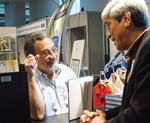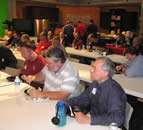ATSC Mobile DTV
Instructional Method: Online, On-Demand Webinar
This webinar is brought you to by SBE and ATSC (Advanced Television Systems Committee).
Overview
The two-year effort to develop a comprehensive system for mobile and handheld digital television services—known as ATSC Mobile DTV—has moved from standardization to implementation. This milestone, along with the launch of other mobile delivery systems, has ushered in a new era for content suppliers and distributors.
Part 1 - Physical Layer: Wayne Bretl, Zenith/LG
This part introduces the layered structure of the ATSC Mobile DTV System, and then describes how enhancements to the ATSC 8-VSB physical layer provide robust reception under mobile conditions, and how a variable part of the data in the ATSC channel can be allocated for mobile use.
Part 2 - IP Transport: Rich Chernock, Triveni Digital
Until recently, MPEG-2 Transport Streams have been the only means used to carry Digital Television (DTV). MPEG-2 provides the necessary underpinnings for broadcast quality delivery of DTV content, including a well-established timing and buffer model. The ATSC Mobile DTV standard has chosen to instead use IP transport for both streaming and file content (compatibility with other emerging mobile systems was one of the reasons for this choice). This presentation explains the use of IP transport in ATSC Mobile DTV for both streaming and file content. The protocol stack will be explained, as well as the mechanisms adopted to allow “broadcast quality” to be achieved.
Part 3 - Implementation: Jay Adrick, Harris
The last portion of this webinar provides an overview of the equipment utilized to originate and transmit ATSC Mobile DTV services, including encoders, signaling, ESG, mobile transmission adapters and the transmission exciter. The signal flow and interconnection of these devices with the existing DTV transmission system will also be covered, as well as system and bandwidth planning.
About Your Instructors
Wayne Bretl (wayne.bretl@zenith.com) is a senior engineer at LG Electronics’ U.S. R&D subsidiary, Zenith Electronics. He received the BSEE from Illinois Institute of Technology in 1966, and joined Zenith in 1975. He holds 26 patents in television technology and related areas. A Senior Member of IEEE, and a member of SMPTE, AES, and SID, Bretl represents LG in ATSC and a number of professional and industry associations. He is a co-recipient of the 2006 IEEE Masaru Ibuka Consumer Electronics Award, for contributions to the development of the VSB digital transmission system for DTV broadcasting, and is the recipient of the 2006 SMPTE David Sarnoff Medal Award for contributions to television engineering.
Rich Chernock (rchernock@trivenidigital.com) is currently Chief Technology Officer at Triveni Digital – an LG Electronics Company. In that position, he is developing strategic directions for monitoring, content distribution and metadata management for emerging digital television systems and infrastructures. Previously, he was a Research Staff Member at IBM Research, investigating digital broadcast technologies. Dr. Chernock is active in many of the ATSC and SCTE standards committees, particularly in the areas of mobile DTV, monitoring, metadata, and data broadcast. He is vice-chair of the Technology Standards Group (TSG) and chairing the Non-Real-Time Services and Mobile/ Handheld management layer activities within ATSC. He is a major participant in the SCTE HMS video monitoring activity. He is also the Distinguished Lecturer Chair for IEEE BTS.
In another life, he used transmission electron microscopy to study materials characteristics for advanced ceramics packaging and semiconductor technology at IBM. His ScD was from MIT in the field of nuclear materials engineering.
Jay Adrick (jadrick@harris.com) is a 46+-year veteran of the broadcast industry and a leader in the design and integration of digital broadcasting systems. Jay is a member of the Harris Broadcast CTO team. In his current position at Harris, he is leading the development of the ATSC Mobile DTV system, providing strategic guidance for the development of new broadcast products and representing Harris in the world of broadcast standards. Earlier in his career at Harris, Jay led the teams that designed and built many of the leading broadcast facilities including The Golf Channel, The Weather Channel, The Discovery Channel, National Public Radio, The Voice of America, Georgia Public Broadcasting, Iraqi Media Network and many other broadcast facilities. He also led the product development for the Harris FlexiCoder, MasterPlus and MonitorPlus products during the early part US digital rollout as well as leading the technical team that designed, built and operated the Harris/PBS DTV Express. In addition to his Harris duties, Jay is member of the board of directors and Vice Chairman of the Advanced Television Systems Committee. In addition, he has served on both of the FCC Media Security and Recovery Councils. A member of the Society of Broadcast Engineers, Society of Motion Picture and Television Engineers and the Society of Cable Telecommunications Engineers, he has authored and presented a large number of technical papers and chaired various technical presentations.
SBE Recertification Credit
The completion of this webinar from Webinars by SBE qualifies for 1 credit, identified under Category I of the Recertification Schedule for SBE Certifications.
Registration
This webinar is brought to you by SBE and ATSC. ATSC Members should select 'Member' and put in their ATSC Member number to receive the member rate.
This webinar is approximately 1 hour 40 minutes long.
SBE and/or ATSC Members: $39
Non-Members: $55
Questions
If you have questions regarding this course, contact Kimberly Kissel via email or by phone at (317) 846-9000.










